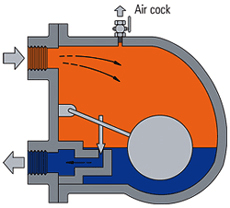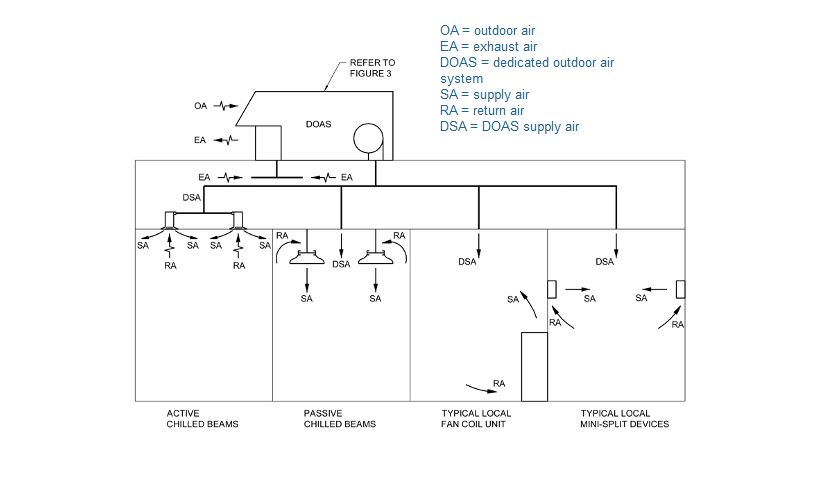
I flipped open AESP’s[1] annual magazine to pick up a topic for this week. I chose the last article on natural gas programs. I’ve always found it interesting that folks perceive natural gas to be an enigma for finding savings. If natural gas is being used, the potential for savings is not more difficult to find than electricity savings.
Steam “Traps”
Let’s start with steam traps. Programs that maintain and replace steam traps are akin to electric programs that fix compressed air leaks.

Traps capture things, right? Mousetrap. Ant trap. Beartrap. Ackbar trap. However, a steam trap doesn’t trap steam. It doesn’t trap anything. It releases condensate from the steam system, like a condensate drain, which is what they are called in compressed air systems.
There are many types of steam “traps.” A cartoon of one is shown nearby. This one is provided because of its simplicity. It is a cutaway (sawed in half, parallel to your screen) of a float trap. The orange space represents steam and the blue space is the condensate (water). The ball floats in water as it accumulates and rises. Eventually it opens the port to drain away condensate, which flows back to the boiler, where it is boiled to make steam again. Like compressed air, steam is where the value is. If it rolls on through, it is mostly wasted. Most steam systems (at least in commercial buildings) are vented to the atmosphere. The heat of the steam is lost outside the system it was meant to serve.
Steam traps are often forgotten and ignored for longer than they should be unless something stops working. For instance, say the ball on the cartoon breaks off the lever to which it is attached. There is nothing to open the port and drain the condensate. Soon, the “trap” will be full of water, and everything upstream will be backed up (plugged). Whatever was being heated, is no longer heated because it soon becomes room temperature, so to speak. That problem will be found and fixed promptly because the equipment it serves is no longer functioning as intended.

Steam trap programs are legitimate, but they require a decent assessment of baseline and measure life. What is standard practice? How often are traps typically fixed or replaced? And, like compressed air leaks, determining steam trap losses, thereby, savings potential, is an art. But I am here to tell you, professionals, like doctors, can listen to a steam trap and accurately estimate loss, and therefore savings – especially when aggregated for a whole building.
This is where we are going, folks. The savings are substantial and real, but determining them takes money. It can be done.
HVAC
Heating, cooling, and ventilating systems have equal amounts of operational savings for both heating and cooling energy. If heat is provided by natural gas, natural gas savings ensue. I think you brilliant readers can understand the cartoon below with a little explanation. It depicts a common configuration for a modern HVAC system for a commercial building. However, the system is not so common; thus, efficiency programs have a ways to go. That’s a Rant for another day.
 This dedicated outdoor air system “DOAS” is a great design I’ve been pushing for at least a decade, but again – a Rant for the future. It is great because it doesn’t require ridiculous volumes of airflow and it also avoids unnecessary mixing of airflows which makes control much more difficult. However, the purpose of putting this in this blog is not to describe how great it is but to describe a typical operational flaw.
This dedicated outdoor air system “DOAS” is a great design I’ve been pushing for at least a decade, but again – a Rant for the future. It is great because it doesn’t require ridiculous volumes of airflow and it also avoids unnecessary mixing of airflows which makes control much more difficult. However, the purpose of putting this in this blog is not to describe how great it is but to describe a typical operational flaw.
The typical DOAS unit will be controlled to supply air at a neutral temperature to each space, where a separate unit, like a heat pump, conditions the space independently. By the way, we’ve reached a new low in acronyms. I learned the DSA shown in the cartoon, is an acronym squared. Part of the acronym “D” is an acronym, “DOAS.” DSA = DOAS supply air. Good grief.
The DSA temperature is typically room temperature, 70F. This is one of those questions plenary speakers like to ask. How many of you think this is the best temperature to supply?
Wrong.
When ventilation is continuously supplied to a space, there is almost always a need for heating or cooling in the zone (think of a broken clock that is right twice a day). If the 40F outdoor air is heated to 70F in the DOAS unit and the space needs cooling because it’s full of people, we have just heated air at the DOAS unit and then cooled it in the zone: simultaneous heating and cooling.
My saying is this: if simultaneous heating and cooling can happen,[2] it is. The only question is, how much?
Let’s move on to more natural gas opportunities next week. This was fun.
[1] Association of Energy Services Professionals
[2] The design is such that it can happen.
